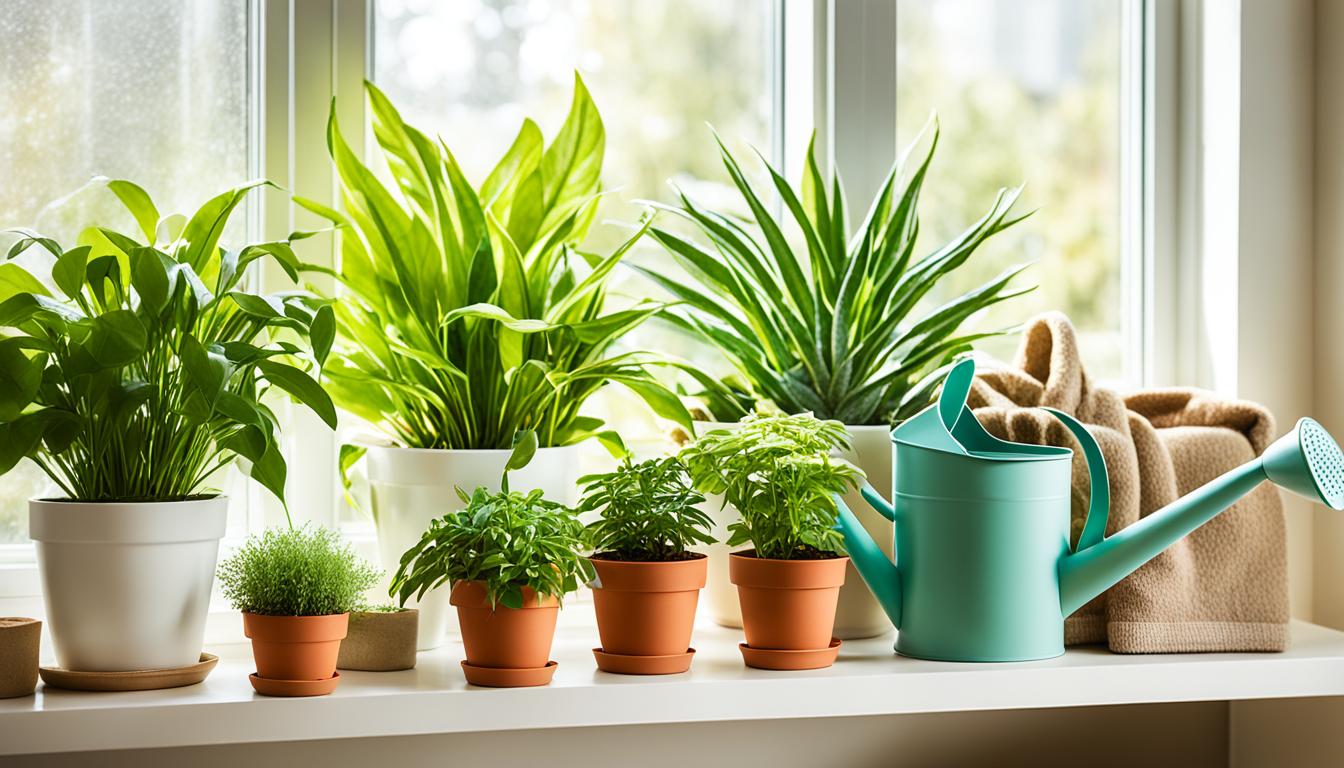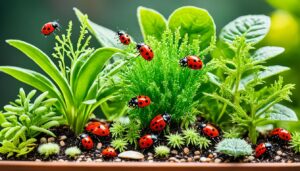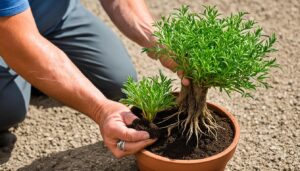Is your indoor plant looking sad and struggling in the cold? Don’t worry, you can help your houseplants stay healthy during winter. We’ll share tips to keep your indoor plants looking great, even when it’s cold.
Adding houseplants to your home can brighten up the winter. Whether you’re new to plants or have been growing them for years, our advice will help. Follow these steps to keep your indoor plants happy, no matter the weather.
Adjusting to Low Light Conditions
As winter comes, your indoor plants may not get enough light. But don’t worry, there are ways to help them. You can make sure your houseplants stay healthy, even when it’s dark.
Increase Lighting for Indoor Plants
Adding grow lights is a great way to make up for less sunlight. Grow lights give plants the light they need for photosynthesis. When picking grow lights, choose ones that have different color temperatures. This helps your plants get the light they would get from the sun.
Move Plants Closer to Windows
Another trick is to move your plants closer to windows. This lets them get more natural light. If your plants start leaning towards the window, turn them every few days. This keeps them growing evenly and prevents them from getting crooked.
Using these tips, your indoor plants can handle the low light of winter. They’ll keep growing strong through the cold months.
Proper Watering Techniques in Winter
When it gets colder and days get shorter, your indoor plants need less water in winter. They slow down and use less water because they’re in a dormant state. Overwatering can cause root rot and other problems. So, it’s important to change how often you water them.
Reduce Watering Frequency
Water your indoor plants less often in winter than in spring and summer. Always check the soil moisture before watering. Wait until the top inch or two of soil is dry before watering again. It’s safer to underwater than to overwater, as plants can recover from drought but not from being too wet.
Check Soil Moisture Before Watering
Before watering, stick your finger into the soil to feel the moisture. If the soil is damp, wait to water. When it feels dry, it’s time to water. This method prevents overwatering signs like yellow leaves, wilting, and root rot.
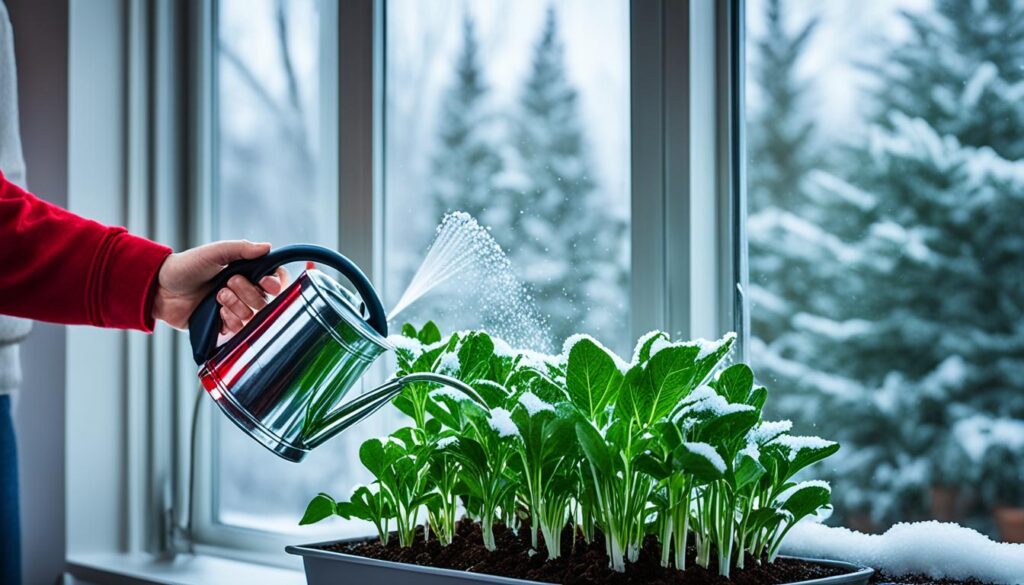
“It’s better to err on the side of underwatering during the winter months than to overwater your plants. Overwatering can lead to a host of issues that are difficult to recover from.”
By paying attention to your plants’ water needs and adjusting your watering, you can keep them healthy and happy all winter.
Managing Temperature Fluctuations
Keeping a steady temperature is key for your indoor plants’ health, especially in winter. Sudden changes from cold drafts or hot air vents can stress and slow down your plants.
Avoid Cold Drafts and Hot Air Vents
To shield your plants from winter’s harshness, think about where you place them. Keep them away from open windows, doorways, and heaters that cause big temperature changes. Most indoor plants do best in a temperature around 75°F.
Try to keep their environment steady and suitable for them.
- Look for and fix any cold drafts at home, like leaky windows or doors.
- Move your plants to spots not hit by hot air vents or radiators.
- Think about using insulating materials, like clear plastic sheeting, to shield your plants from cold drafts.
By doing these easy things to keep houseplants away from heat sources, your indoor plants will do well in the cold months. They’ll stay lively and keep growing strong.
Indoor Plant Care in Winter: Common Challenges
When it gets colder and days get shorter, your indoor plants may face challenges in winter. Knowing about these issues can help you keep your houseplants healthy during the cold season.
Leaf Drop and Dormancy
Some indoor plants drop leaves or go dormant in winter. This is how they adjust to less light and slower growth. Seeing leaves fall might worry you, but it means your plant is resting naturally. Let it rest and care for it properly to avoid stress.
Houseplant Pests in Winter
Warm, dry indoor spaces are perfect for pests like aphids, scale, and spider mites. These pests love winter, so check your plants often and act fast to stop them. Clean leaves, stems, and soil to get rid of pests. Use natural pest control to keep your plants safe.
“Maintaining the health of your indoor plants during the winter is all about understanding their unique needs and adjusting your care routine accordingly.”
Being aware of leaf drop in winter, plant dormancy in winter, and common indoor plant pests in winter helps your plants thrive in the cold. With the right care, they can make it through winter strong and ready for spring.
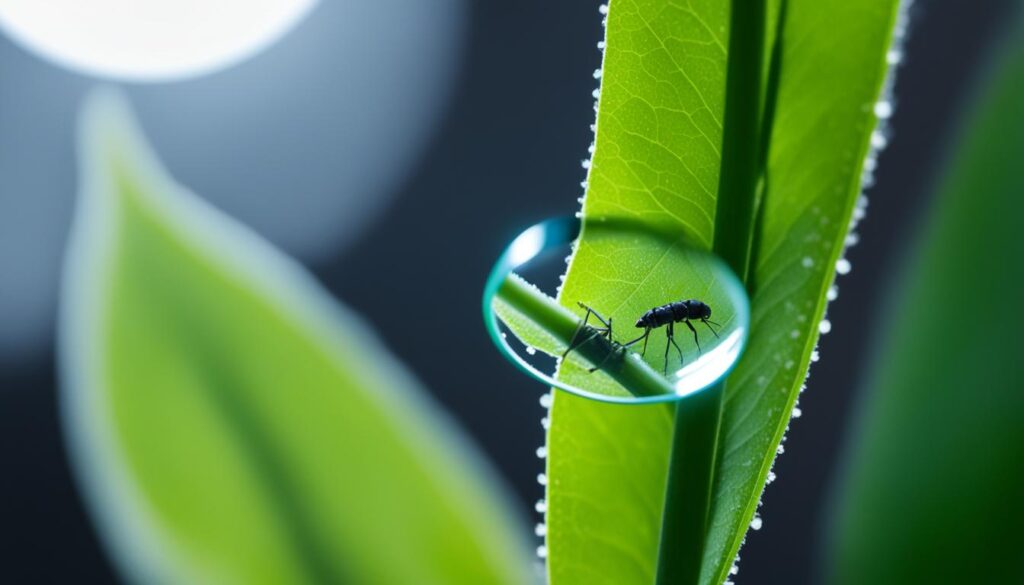
Humidity for Indoor Plants in Winter
When our homes get drier in winter, many tropical houseplants may struggle. But, there are ways to increase humidity for indoor plants and keep them healthy. These methods help them survive the cold months.
Grouping your plants or putting them on trays with pebbles and water can help. This creates a microclimate of higher humidity around them. Misting can help for a short time, but a humidifier is better for a lasting effect.
Humidifiers add moisture to the air, making it perfect for your plants. They’re great for plants like ferns, palms, and calatheas. Just remember to clean and maintain your humidifier to avoid mold or bacteria.
Keeping humidity up for indoor plants in winter is key to their health. With these easy steps, you can make sure your houseplants do well, even when it’s very dry.
Conclusion
By following some simple tips, you can make sure your indoor plants do well all year. Adjusting the lighting, watering, temperature, and humidity can help. This way, your houseplants will stay lush and vibrant, even in the cold winter.
It’s important to keep your plants happy and healthy all year. This means giving them the right care, no matter the season. By moving plants near windows, watering them less, or using a humidifier, you can help them thrive.
With the right techniques and dedication, you can enjoy your indoor garden all year. So, take the time to care for your plants. Keep them healthy and beautiful through the winter and beyond.
FAQ
How can I adjust the lighting for my indoor plants in the winter?
To help your indoor plants adjust to winter’s lower light, move them closer to windows for natural light. Use grow lights to supplement their lighting needs. Rotate plants every few days if they lean towards the window.
How often should I water my indoor plants in the winter?
Indoor plants need less water in winter as they slow down. Water them less often, waiting until the soil is dry before watering again. It’s safer to underwater than overwater, so check the soil moisture first.
How can I protect my indoor plants from temperature fluctuations in the winter?
Keep your plants away from cold drafts and hot air vents to avoid sudden temperature changes. A consistent temperature of 75°F is best for most indoor plants.
What are some common challenges with indoor plants in the winter?
Houseplants may drop leaves or go dormant in winter. This is how they adjust to less light and slower growth. Watch out for pests like aphids and spider mites in the warm, dry indoor air. Regularly check and remove any pests you find.
How can I increase the humidity for my indoor plants in the winter?
The air in heated homes gets dry in winter, which can harm many plants. To add humidity, group plants together or use trays with pebbles and water. A humidifier can also help create a humid environment for your plants.


